All the Wonderful Places You Can Go on an Oman Road Trip With a 2WD Car
The best way to see Oman, as I discovered in November, is by taking a self-driving road trip in a rented car. Unless you’re part of a tour group or hire a private guide, it is difficult to access everything the country has to offer on your own. Even if one can catch the infrequent ferries or long-distance coaches, many sights are far from major cities.
On the other hand, the wide, well-maintained roads make self-driving in Oman a breeze. Also, they pass through a wide variety of landscapes. Think mountain canyons, towering dunes, stunning beaches and ancient mud-brick villages and forts. If you thought New Zealand was stunning, you will be awe-struck here.
If you’re looking for a sample itinerary for an Oman self-drive tour starting and ending in Muscat, the capital of the Sultanate, you’ve come to the right place. Since I took the most economical way, i.e. a 2WD car, I can tell you where you can go, and that you won’t miss much by not paying for a 4X4 SUV.
A 2WD Self-Drive Oman Road Trip Itinerary
Before you go
- Do a rough calculation of the driving distance you’ll cover before deciding whether to go for a rental with a mileage limit. As long as you don’t massively exceed it, the cost will be substantially lower.
- Check the activities that your insurance covers. Going off-road in a 2WD car is a definite no, and the police will stop you in some places. The itinerary below includes more details.
- Unless you intend to live in Oman, your home country’s driving license will suffice.
- Generally, the best time to take a self-drive road trip in Oman is from December to February. The temperatures are at their most comfortable at this time. November and March are a bit hotter but still tolerable. There is little shade from the intense sunshine, however, so switching off the car’s air-conditioning is for masochists.
- If you decide to camp, rent your tents and camping equipment from the company that you rent your car from or a travel agency instead of buying the cheap hypermart stuff. Request a recommendation on the Tripadvisor forum.
TL;DR
Where can I drive a two-wheel-drive (2WD) car to in Oman? Muscat, Bimmah, Wadi Shab, Wadi Bani Khalid, Qalhat, Sur, Ras Al Hadd, Ras Al Jinz, Pink Lake, Nizwa, Misfat Al Abriyeen, Bahla, Al Ayn, Jabrin/Jibreen, Dibba, Khor Najd and the edge of the desert.
Where do I need a 4×4 SUV in Oman? Wadi Tiwi, Jebel Akhdar, Jebel Shams, Jebel Harim and deep into Wahiba/Sharqiyah Sands.
Click on the link if you don’t drive, or want more tips on checking Oman out on a budget
Day 1/2: Muscat and around
You probably just landed at the shiny new Muscat International Airport (as I did from Doha), or you may have driven six hours from Dubai to Muscat by road. By this time, you should have applied for a 10-day visa before arriving, and the pleasure of waltzing straight through immigration should set you back 5 rials. You can rent a car in the arrivals hall or in the city, but the international brands are in the former. If you’re doing just a short layover in Oman, however, you’re better off getting an oTaxi and checking out Lauren’s ideas.
Muscat’s districts are spread over 50 km along the coast, and the airport is in the most westerly of these. I’d recommend staying in Bowshar the first night for the following reasons:
- Top up supplies at the Lulu and Carrefour hypermarts in the Oman Avenues Mall and Muscat Grand Mall;
- If you want to take things easy before moving onto local food, there are plenty of international chains in those shopping centres;
- If you’re tired or only planning to rent a car the next day, it’s a relatively short distance from the airport; and
- The Sultan Qaboos Grand Mosque is nearby, so you don’t have to backtrack too much in the morning.
The Sultan Qaboos Grand Mosque‘s visiting hours for non-Muslims are 8 to 11 a.m. from Saturday to Thursday. Everything about it is beautiful, including the mosaic niches, the giant prayer hall rug and chandelier (once the world’s largest) and the view at night. The arches and the passages are especially conducive to Instagram shots, so if you want a crowd-free shot, go early. Remember to dress conservatively and wear a headscarf.
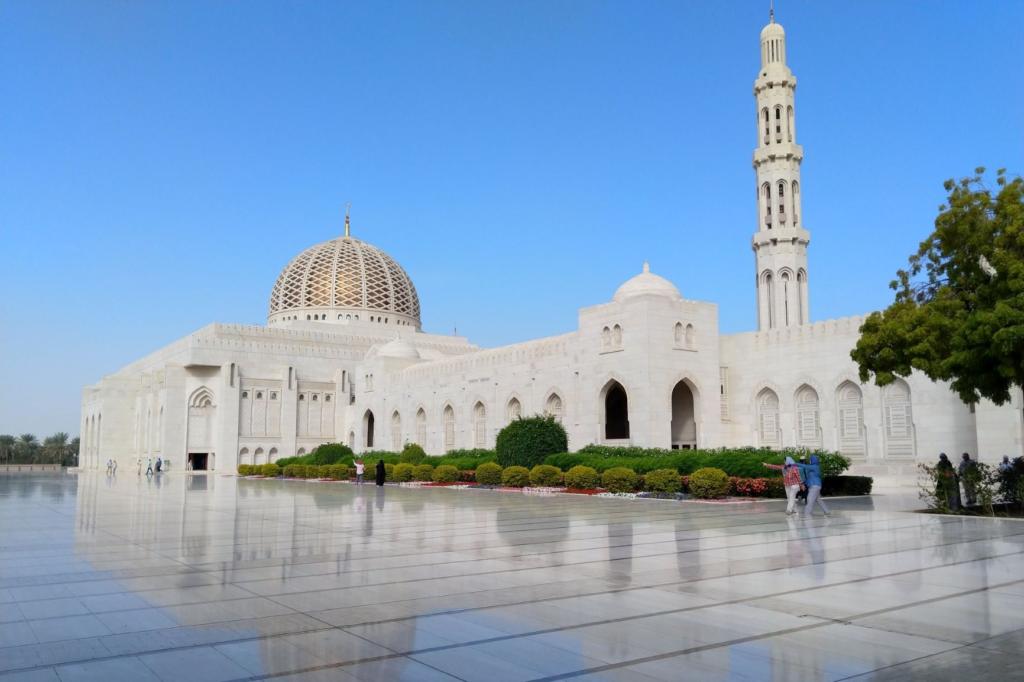
Following your visit to the mosque, head east on Sultan Qaboos Street to tour the Royal Opera House or catch some rays on Qurum Beach. If the idea of tanning in a t-shirt and knee-length shorts doesn’t appeal to you, proceed straight to Mutrah, where the old city is. Don’t go all out for the souvenirs in the souq, however; you can get better quality and lower prices in the other towns or the Omani Heritage Gallery.
Stroll along the Corniche from the fish market to Al Alam Palace, taking in gardens, forts and museums such as Ghalya’s Museum of Modern Art (which features exhibits on life in Oman in the mid-20th Century), the National Museum and the French Museum.
For dinner, consider Bait al Luban for a taste of the local cuisine. It’s on the pricey side but so worth it, especially the shuwa, and you can enjoy a view of the Corniche from the balcony. To do some scuba diving, drive down to Bar Al Jissah and spend an extra day there.
Day 3: Muscat to Bimmah, Wadi Shab and Sur/Ras al Jinz
Wherever you start the morning, make your way early to Highway 17 and head southeast towards Sur. It’s going to be a long day, so leave Muscat no later than noon.
After driving 1.5 hours, you’ll reach Bimmah Sinkhole (don’t worry, the turn is well-posted). The area around the flooded sinkhole is now a park with proper facilities, and there are concrete steps to reach the pool at the bottom. One can cool off in the water or get nibbled on by the fish. As long as it hasn’t rained in a couple of days, the water here and in other places will be crystal clear.
A further 30 minutes away is Oman’s most famous valley, Wadi Shab. Once you’ve parked and taken the motorised boat across the river, allow 45 minutes each way for the trek through one of the country’s best wadi. Expect your heart rate to rise as you clamber up and down the rocks while lush cliffs tower high above you. Even with the presence of pipelines, the wadi embodies Oman’s rugged beauty. At the end is a pool and if you swim through the gap in the rocks, you’ll reach a waterfall. Don’t linger too long, though; the last boat back departs at 5 p.m.
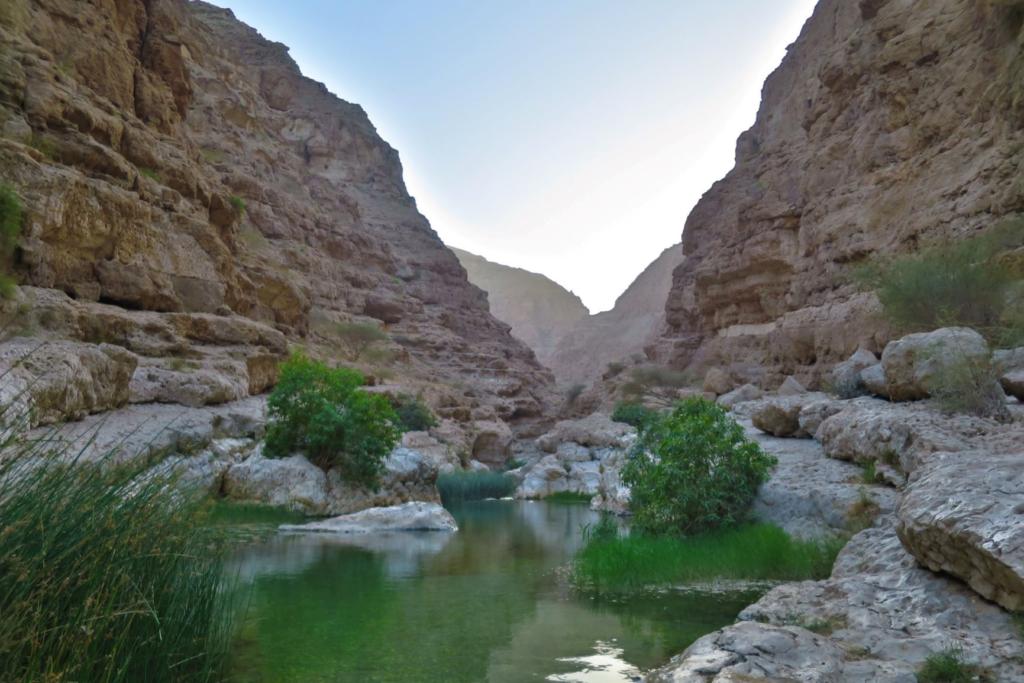
If you have an extra day, a 4WD SUV and an experienced driver, you can visit the quieter Wadi Tiwi. I didn’t have any of those and wouldn’t recommend going without them because it’s a steep and narrow road. I did, however, get invited to stay with a local in the village, so I compressed the drive from Qalhat to Sharqiyah sands into the next day.
The ancient city of Qalhat is another 20 minutes from Wadi Shab and Oman’s latest UNESCO World Heritage site. Its main attraction is the Bibi Maryam mausoleum, a ruined shrine from more prosperous times. Conservation work is taking place right now, so I saw it only from a distance. Take the road that circles the city until you reach the date plantation. Park there, then cross the riverbed and climb the slope. Expect the caretaker to yell, “Close! Close!” at you.
From Qalhat, it’s 40 minutes to the port of Sur and a further hour to the turtle nesting sites of Ras al Jinz and Ras al Hadd. I skipped the latter because the idea of handling and posing with wild turtles doesn’t jive with me any more. The locals did say, however, that camping is allowed at the latter beach. If you’d like to avoid startling the creatures, turn off your car headlights as you approach the sites, cover torchlights with red cellophane and don’t get too close to them. Book ahead to stay at the respective resorts.
Elsewhere: Songs to add to your road trip playlist
Day 4: Sur to Wadi Bani Khalid
In the morning, you can return to Sur. Park at the eastern end of the Al Ayjah bridge, enjoy the view of the watchtowers by the sea and visit the dhow workshop on the other side to see how these wooden vessels are built. You may run into a few tourist groups, but it’s not very crowded. Taking a look around is free, and you can pick up souvenirs like miniatures or shark tooth pendants. After that, take the inland route on Highway 23 to Wadi Bani Khalid for about two hours.
Alternatively, from the turtle reserves, follow the coastal road south to the Pink Lake just before Ras al Ru’ays. The high level of salinity in this lagoon kills everything but pink algae and the wild flamingoes that feed on them. It’s the more accessible of the two pink lakes in Oman that exhibit this phenomenon. After crossing the bridge that separates the lagoon from the sea, I turned off the road and parked among the buses before walking down to the salt-crusted shores. When the flamingoes decided to desert me, I rejoined Route 23 at Al Kamil via Jalan Bani Bu Ali. The detour took an additional 1.5 hours over the inland route, inclusive of the stop.
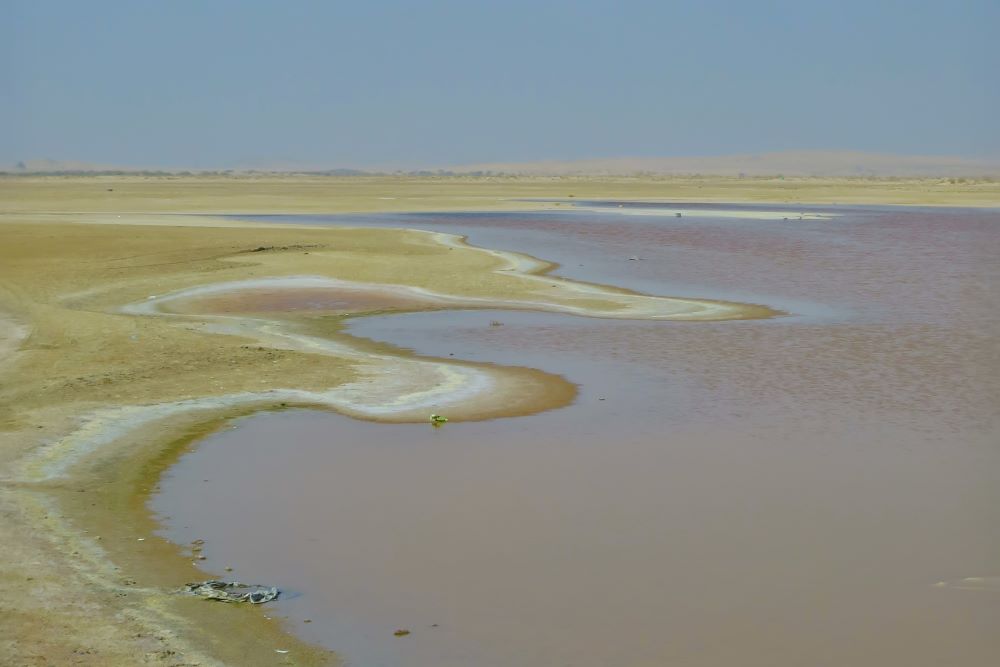
There is only one way in and out of Wadi Bani Khalid, and it starts near Oriental Nights Rest House. The elevation change is pretty steep so mind your brakes and fuel usage. When you get there, you’ll find a much more developed area than Wadi Shab. There are smooth pavements, pavilions and even a simple buffet restaurant. It felt almost resort-like to me. Beware the fish in the water, however; unlike those at Bimmah, they take big, vicious bites out of tourists! If you crave something more rugged, you can do a short hike to a pool above the waterfall and a cave in the valley.
If you’re not intent on catching the sunset among the desert dunes (more on that later), you can spend the night at the Oriental Nights Rest House.
Day 5: Shaqiyah/Wahiba Sands
Here’s another place where you cannot take a 2WD car in Oman. Even if you have a 4X4 SUV, you’ll need to deflate the tyres before driving on the soft sand, and you probably don’t have any experience driving on the dunes anyway. Many Omani tour agencies and desert camps will advise you to park in Bidiyah, and they will pick you up in their vehicles. You can spend the day dune-bashing and sandboarding, or learn about the Bedouin way of life with these businesses.
As for me, the pick-up, the guides and the camps were too expensive for solo backpacking in Oman. I drove to Al Wasil instead, taking the road that cuts through the dunes southwest of the town. I parked to the side near the start of the dirt road, and that was my version of a desert camp. Climbing the dunes was exhausting but worth the view, but remember to return before the winds cover your tracks.
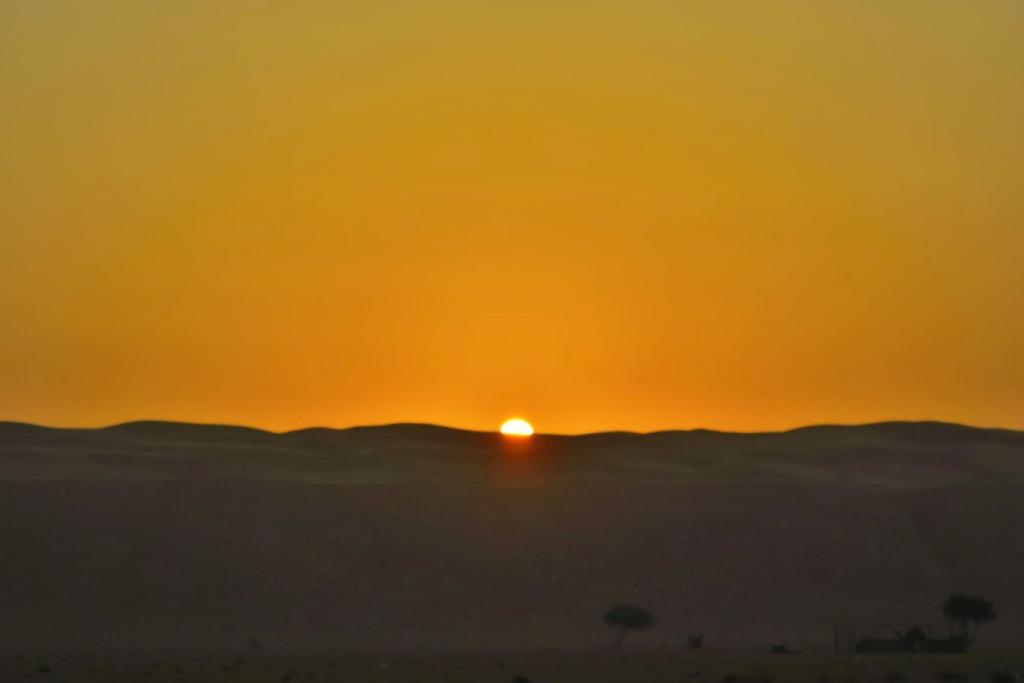
Day 6/7: Sharqiyah Sands to Nizwa and Muscat
If you’re as unlucky on the drive to Nizwa as I was, you may miss the turning in Ibra due to the roadworks. I spent three hours driving there via Fanja. I hope someone succeeds in shaving an hour by going through Lizq and Sinaw or Izki and comments below!
The old city of Nizwa is dominated by the famous souq and a massive cylindrical fort. The latter charges a hefty admission fee of 5 rials to see the performances and exhibits that describe life under the ancient Imams that ruled this region. The souq has several sections where you can buy khanjar (ceremonial daggers), frankincense and burners, fish and the best dates in the Arab world.
If possible, time your visit so that you can be part of the goat market that takes place on the south side on Friday mornings. Watch the locals unload their livestock at the crack of dawn before the raucous parade and auction begins at 7. It’s a common sight across the Sultanate, but this is the most famous edition. If it means doing this itinerary in reverse, go for it.
In the meantime, the countryside has plenty of gems that can be explored in eight hours. I took the ring road to see the ruins of Tanuf’s mudhouses, then drove up the mountainside to Misfat al Abriyeen to see the ancient village and waterways. The local honey also has an unmistakable flavour. Along the way, you can also stop at the Al Hoota caves. It’s about as far as you can go to the Al Hamra mountains. If you don’t have a 4X4 to explore the canyons in the range or reach Jebel Shams, the police will stop you at the checkpoint. Once again, local tour agencies and the Jebel Shams resorts can rescue you.
After visiting Misfat, I stopped at the imposing Bahla Fort (admission is 500 baisas). Oman’s first UNESCO World Heritage Site offers an impressive view of the mountains, the surrounding towns and their date plantations. The rooms lack exhibits and descriptions, however. On the other hand, the nearby Jabrin Fort (also 500 baisas) describes the parts of its compound in far more detail through signs and an audio tour.
From Jabrin, it takes an hour to get to the mysterious Al Ayn beehive tombs. Despite the name, no one knows what purpose these prehistoric structures served. To get there, follow the signs for the turn off Highway 21. Park in front of the farm – where you should be able to see the tombs in the distance – and cross the plantation and riverbed. The walk takes only 10 minutes.
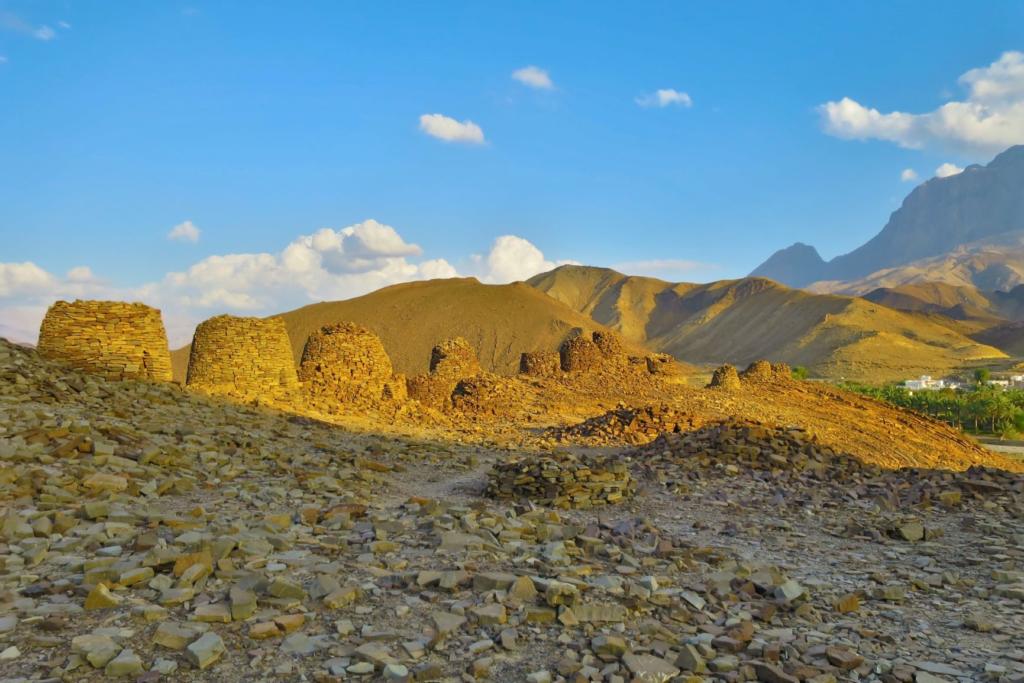
If you can’t get enough of the ancient villages before you leave, you can stop by Birkat al Mouz on the way back to Muscat. Even in its crumbling state, the aflaj (canals) still work and supply the squatters with drinking water from the mountains. It takes two to two-and-a-half hours to reach Muscat; you’ll know your close when the traffic on Route 15 becomes heavier. Refuel and wash the car at one of the petrol stations on your way to the airport, then catch your afternoon flight out of Muscat.
Altogether, the route I described covers a distance of roughly 1350 km, including a few missed turns.
What about driving to Salalah?
Wouldn’t it be nice to visit the Land of Frankincense? Of course, especially during the Khareef (monsoon) – while the rest of Oman burns up in the summer, the southern landscape becomes verdant practically overnight thanks to frequent cooling rain showers. However, it’s a 12-hour drive each way between Muscat and Salalah, and so many people choose to fly instead.
Driving around Khasab and the Musandam Peninsula
Driving from Muscat to Musandam requires one to cross the United Arab Emirates, and the route depends on where you want to go. I didn’t drive to Dibba, but the straightforward route hugs the shore of the Gulf of Oman. However, one can’t cut across the mountains to get to Khasab; the journey involves a drive to Ras Al-Khaimah before following the coastal road there.
As for me, I flew to Khasab from Muscat and rented another 2WD car there. If you choose to fly too, sit on the right-hand side of the plane to admire the fjord-like landscape from above as you land. It takes 30 minutes to drive to the Al Khalidiya acacia grove to the east, passing through vast wadis, and a little more than that to reach Bukha on the west coast (if there are no roadblocks), where the windy, scenic route hugs the rocky coast.
The road to the hidden cove of Khor Najd is not sealed and covered in loose stones; however, it can still be done carefully with a saloon car. It took me about 35 minutes to inch my way to the viewing point, holding up a couple of SUVs along the way. Going down to the shore of the lagoon was not on my agenda, but it’d take much more time than it was worth.
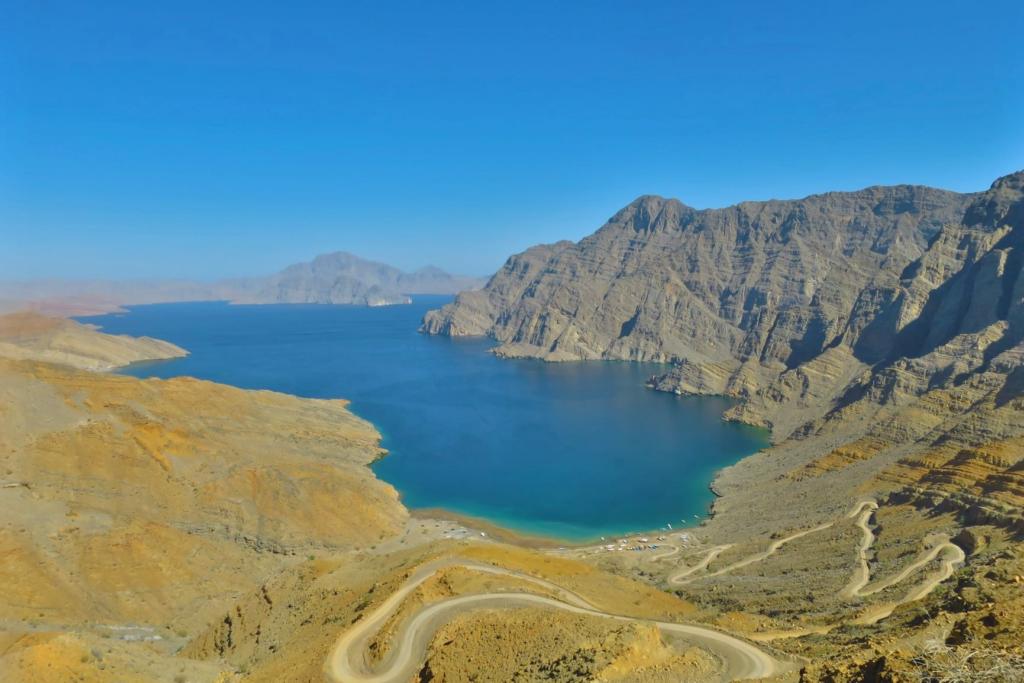
Important Rules and Tips
- As with any other car rental, pore over the vehicle for minor dents, cracks and stains, and check that all the lights and fluid levels are okay before driving away and returning the car.
- The first of the travel apps to download in Oman is Waze. While it’s the most reliable app for navigation in the region, be careful. There were places where I couldn’t turn left as advised and there’s plenty of work on Highway 23 that renders it inaccurate.
- The other app to download is OTaxi. Your savings through this Oman ridesharing app over regular taxi fares are substantial.
- Don’t park overnight in front of houses, public buildings and mosques.
- Beware of flash floods after the rain. Even in the city, drainage is terrible, so there will be plenty of standing water. If you see the water reach the red mark in a wadi crossing, don’t attempt to ford it.
- Slow to a crawl when you reach one of the many speed bumps in towns. Your car may bottom out on one of these sleeping policemen if you drive too fast.
- While Oman’s major roads are wide, well-maintained and relatively safe, watch out for stray goats, donkeys and even camels.
- When you refuel before returning the car, send it for a wash and interior grooming at the same time; otherwise, the rental company will bill you for it. Many pump stations offer this service.
Cost of an Oman self-driving tour
- Car rental: From 10 rials a day inclusive of insurance
- 10 litres of water per person: 750 baisas
- Cost of petrol in Oman: ~12 rials for a full tank (55 litres)
- Sedan car wash and grooming: 2 rials
- Parking and camping are free in many places
- Add 15 rials a night for accommodation and 2 rials per meal. Add more if you want more comfort.
You’ll find that for couples and solo travellers in Oman, it can be much better value to rent a car than to take multiple private guided tours from Muscat.
5 Reasons You Need to Visit Oman Right Now! - Exploring Kiwis
13/07/2019 @ 2:31 PM
[…] safe and drivable, it’s a place you really should […]
12/11/2019 @ 7:38 AM
Hello. I’m an expat working here in Muscat. I recently started driving and owned a saloon car. I was planning for a roadtrip with my friend and looking for places where I can use my car. I’m glad I found your blog. It was amazing how detailed you informations are. All are true and up to date. Thank you.
13/11/2019 @ 1:49 PM
Glad to have helped!